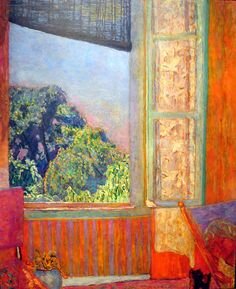Discovering the Artist
Pierre Bonnard
Most of us take color for-granted. We are never taught to stop and observe color because we swim in it every day. The impressionists taught us to be mindful of color as did the post impressionists. It is hard to stop, observe, and spend time seeing color because it takes practice.
Pierre practiced seeing color. He was mindful of every day scenes, like observing windows inside and out at the same time as shown below. His colors worked together in the same way an orchestra does instruments, with each one complimenting the other in an arrangement or composition. They appear as maps of color leading the eye in and out of spaces within each composition.
QUESTIONS to CONSIDER:
Can you see a woman in the two paintings above?
Is there a foreground, middle ground and background or are they all one flat image?
What is the dominant color in each painting?
Are lines important in these pieces?
What do these four pieces have in common?
What single color do these 4 works have in common?
Is this painting an example of symmetrical or asymmetrical composition?
Pierre Bonnard was born in the French town of Fontenay-aux-roses just southwest of Paris. The son of a prominent officer in the Ministry of War, Bonnard was raised in comfortable bourgeois surroundings, which he abandoned for the bohemian lifestyle of a Parisian artist. By the late 1880s, Bonnard was living in Paris and had met Edouard Vuillard, Maurice Denis, and Ker-Xavier Roussel, the young avant-garde painters with whom he founded the Nabis—an artist group named after the Hebrew word for prophet. Starting in the 1890s, Bonnard and the Nabis pushed Impressionism toward bolder use of color and simplified patterning that bordered on abstraction.
Pierre Bonnard was French. Did you know that French makes up half of the english language?
Here are some phrases in French, can you decipher what they mean? Find the english translation at the bottom.
Pierre Bonnard est un artiste renommé du 20ème siècle.
Pierre Bonnard était un peintre.
Pierre Bonnard nous enseigne la couleur en tant que symphonie.
English translation:
Pierre Bonnard was a renowned artist of the 20th Century.
Pierre Bonnard was a painter.
Piere Bonnard teaches us color as a symphony.
Within these two still life paintings notice how the colors compliment each other. Observe how the backgrounds push the objects forward and yet they seem vector or flat. Bonnard flattens out his colors as if he could take an image and place it on an ironing board to flatten it out.








